Dan De Luce and Lisa Cavazuti
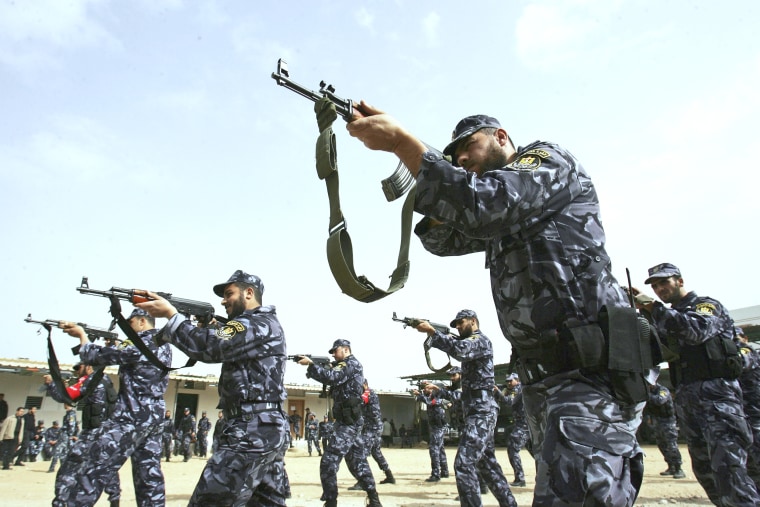
Gaza is plagued by poverty, but Hamas has no shortage of cash. Where does it come from?
Hamas has an investment portfolio of real estate and other assets worth $500 million, say experts, and an annual military budget of as much as $350 million.
Members of the Hamas-led government executive security forces take part in an armed exercise inside their base in 2007.Abid Katib / Getty Images file
The unemployment rate in Gaza is 47% and more than 80% of its population lives in poverty, according to the United Nations. Hamas, however, has funded an armed force of thousands equipped with rockets and drones and built a vast web of tunnels under Gaza. Estimates of its annual military budget range from $100 million to $350 million, according to Israeli and Palestinian sources.
As the U.S. House and Senate will be asking in separate hearings Wednesday and Thursday, where does all that cash come from?
Since coming to power in the Gaza Strip 17 years ago, Hamas has filled its coffers with hundreds of millions in international aid, overt and covert injections of cash from Iran and other ideological partners, as well as cryptocurrency, taxes, extortion and smuggling, according to current and former U.S. officials and regional experts.
Much of the money is public and legal, including large sums of financial aid from Qatar via the United Nations, an arrangement encouraged and approved by Israel. The Qatari aid covers the salaries of civil servants, buys fuel for the power grid and provides cash to needy families.
Some of it is less than legal, according to experts. In addition to levying taxes on Gaza’s businesses and residents, Hamas imposes unofficial fees on smuggled goods and other activity, for a combined income of up to $450 million per year. Hamas also has real estate and other investments around the globe, despite international restrictions, and uses cryptocurrency to mask some of its transactions.
Some of it may be fully illegal. A small portion of its budget seems to come from smuggling in South America, including drug smuggling.
Experts, enemies and Western governments have questioned whether Hamas mingles the money for its military operations with money meant for civilian use. Hamas could not be reached for comment. But Hamas representatives have said previously that the group strictly separates funding for the administration of Gaza from funding for its military wing, also known as the Izz ad-Din al-Qassam Brigades.
In the wake of the Oct. 7 Hamas attack on Israel that killed 1,400 people, some former Treasury Department officials and experts argue that the United States and its European allies need to crack down on the group’s global financial network.
“There will need to be a policy review,” said Jonathan Schanzer, a former Treasury official now with the Foundation for Defense of Democracies think tank.
The Iranian connection
The size of the Hamas budget and its sources have both morphed over time.
Iran has been a consistent financial and military patron of Hamas since the 1990s, long before the group achieved control of Gaza. The funding has gradually increased, and is now at about $100 million annually, according to the State Department.
Hamas leaders have publicly acknowledged Iran’s ongoing financial and military support.
In an interview this month that appeared on Russia Today TV, senior Hamas official Ali Baraka said that “First and foremost, it is Iran that is giving us money and weapons.” Last year, Hamas leader Ismail Haniyeh told Al Jazeera that Iran paid $70 million to the group to support its defense plan.
In addition to Iran’s support, Hamas has long relied on funds from other ideological allies, including private donations and groups in Turkey, Kuwait and Malaysia, former U.S. counterterrorism officials said.
Hamas also has donors in other parts of the world, including the U.S., according to Treasury reports. From 1995 until 2001, the Holy Land Foundation for Relief and Development operated as the chief U.S. fundraising arm of Hamas, sending more than $12 million “with the intent to willfully contribute funds, goods, and services to Hamas,” according to federal court documents and government assessments.
Cash in suitcases
After Israel withdrew from Gaza in 2005, Hamas gained another major benefactor, the Qatari government.
Hamas won an election over Fatah, the Palestinian ruling party, in early 2006, in part because residents believed the existing authorities could not be trusted to administer funds properly. Hamas ultimately seized complete control of Gaza and has ruled without an election since 2007.
As conditions continued to deteriorate for residents of the enclave, Israel, the U.S. and the international community turned to gas-rich Qatar to prevent a humanitarian catastrophe.
Qatari officials began carrying millions of dollars in cash in suitcases through Israel’s Erez border crossing into Gaza, with the permission of the Israeli government.
For Israeli Prime Minister Benjamin Netanyahu, who has been in power for much of the time after Hamas began ruling Gaza, the policy was meant to bring some degree of stability to Gaza and bolster Israel’s security. It also, however, helped fuel the bitter rivalry between Hamas and Fatah, which continued to govern the occupied West Bank.
Under the arrangement, between 2012 and 2021, Qatar provided $1.49 billion in financial aid to support projects for Palestinian civilians in Gaza, a Qatari official told NBC News.
The deal also triggered criticism in Israel and discomfort in Washington. But former U.S. officials, who were in government at the time, said there were no easy options given that Hamas, which had crushed its political rivals, was firmly in charge.
“I think there was broad recognition that the situation in Gaza was pretty awful,” former CIA Director John Brennan said. “There needed to be some flow of funds from somewhere [and] Qatar had the financial wherewithal to do that.”
Neomi Neumann, former head of research for Shin Bet, Israel’s internal security service, said that “we didn’t find any other way to finance this and we didn’t want a humanitarian crisis.”
But from the start, she said, “We knew that it was so problematic.”
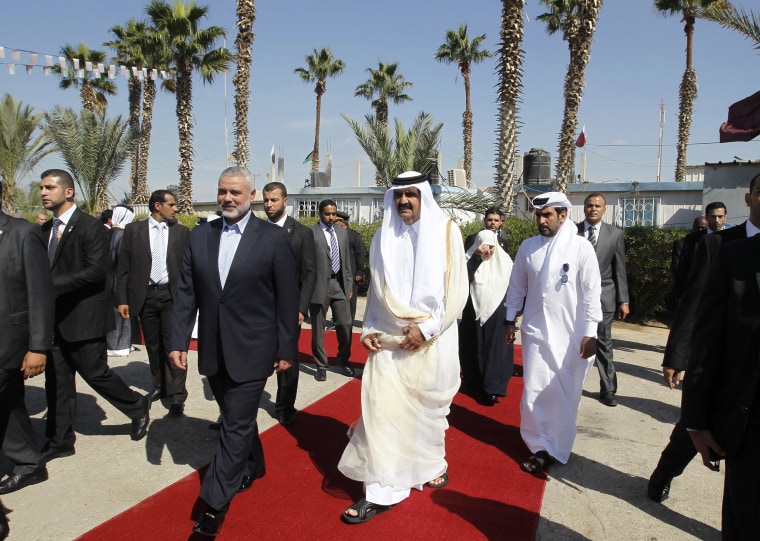 Gaza's Hamas prime minister, Ismail Haniya, center left, walks alongside Qatari Emir Sheikh Hamad bin Khalifa al-Thani at a welcome ceremony at the Rafah border crossing with Egypt in 2012.Mohammed Abed / Pool / AFP via Getty Images file
Gaza's Hamas prime minister, Ismail Haniya, center left, walks alongside Qatari Emir Sheikh Hamad bin Khalifa al-Thani at a welcome ceremony at the Rafah border crossing with Egypt in 2012.Mohammed Abed / Pool / AFP via Getty Images fileIn 2021, Israel and Qatar agreed to a new arrangement that ended the use of cash hand-delivered in suitcases. Instead, the Qatari money was distributed through the U.N. at supermarkets, money exchange shops, post offices and other locations.
The Qatari official told NBC News that Qatar does not provide financial aid to Hamas. “We provide aid to Palestinian civilians in Gaza,” the official said. “Qatari aid is fully coordinated with the Israeli authorities, the U.S. government and the United Nations. All goods such as food, medicine and fuel pass directly through Israel before entering Gaza.”
Qatar says the money has been used for its intended purposes. The Israeli government has “complete oversight over the funds, and would have canceled the agreements if aid was not reaching its intended recipients,” the Qatari official said.
Muhammad Shehada, a Gaza-born Palestinian analyst and writer, rejects claims that aid has been diverted by Hamas. He points to a 2017 Australian government probe that found no evidence that taxpayer money was misused by the nongovernmental organization World Vision in the Gaza Strip, following allegations by Israel that Hamas had siphoned off millions of dollars a year from the charity to the Islamist group.
“Given the tough circumstances in Gaza, the group would have faced a rebellion from their civil servants and the population had there been any evidence of them using government revenue to fund their militant wing,” Shehada said.
But skeptics say the U.N. was unable to exercise strict control over how the money was allocated, and that it enabled Hamas to use tax revenue and other funds to build up its military arm.
“All the funds that were supposed to go to the public, most of it went to their military capability,” Neumann said.
After its takeover of Gaza, Hamas also “developed the capability to tax and extort,” said Matthew Levitt, who worked as a senior Treasury official focusing on countering terrorist financial networks. Hamas began to rake in taxes and kickbacks from salaries, sale of goods and smuggling, a sum that now reaches up to $300 million to $450 million a year, said Levitt, now at the Washington Institute for Near East Policy think tank.
Although the U.S. and the European Union have designated Hamas as a terrorist organization, “they’re not effectively cut off from the international financial system,” said Hans-Jakob Schindler, senior director of the Counter Extremism Project. “They actually are able to invest funds in companies and in real estate.”
Hamas’ leadership has invested its income in an international investment portfolio worth $500 million in real estate and other assets from companies in Algeria, Saudi Arabia, Sudan, Turkey and the United Arab Emirates, which it uses to conceal and launder its money, according to a Treasury announcement.
Cryptocurrencies have helped the group invest its money while bypassing international financial sanctions according to a report by the Counter Extremism Project. To combat those efforts. “Hamas was an early adopter of fundraising in crypto starting in 2019,” said Ari Redbord, a former federal prosecutor and global head of policy and government affairs at TRM Labs, which is working to track Hamas funding. “They were using Telegram channels to solicit donations. They then stood up website infrastructure to solicit donations.” Yet, experts, including Rebord, emphasize that cryptocurrency remains a small piece of the group’s financial strategy.
To some extent, Hamas also supplements its income with various criminal enterprises, experts said. “All large-scale terror groups, such as Hamas, have to ensure that they have multiple, overlapping financing streams, because there is international pressure on its finances,” Schindler said. 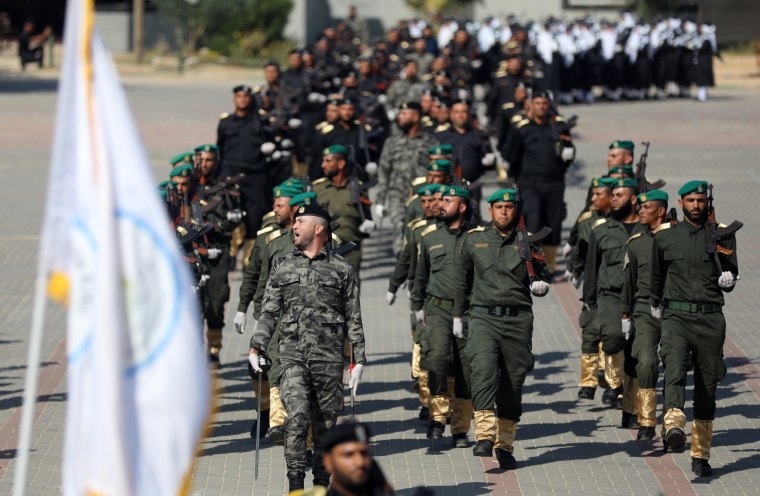 Members of Hamas security march in a military parade at a graduation ceremony in Gaza City last year.Majdi Fathi / NurPhoto via Getty Images file
Members of Hamas security march in a military parade at a graduation ceremony in Gaza City last year.Majdi Fathi / NurPhoto via Getty Images file
 Members of Hamas security march in a military parade at a graduation ceremony in Gaza City last year.Majdi Fathi / NurPhoto via Getty Images file
Members of Hamas security march in a military parade at a graduation ceremony in Gaza City last year.Majdi Fathi / NurPhoto via Getty Images fileFor example, Hamas has a presence in the tri-border area of South America, a region along Brazil, Paraguay and Argentina known as a haven for terrorists and transnational criminal organizations. While experts say the activity there likely makes up a small portion of Hamas’ broader financial apparatus, it participates in drug, arms and people trafficking, smuggling and money laundering operations based there in connection with Hezbollah’s efforts.
Cracking down
During the past two decades, Western governments tended to focus more on cutting off the finances of other Islamist organizations while Hamas received a lower priority, former U.S. officials said. Gerald Feierstein, who worked in the State Department’s counterterrorism bureau from 2006 to 2008, said Hamas was not perceived as a direct threat to the U.S.
“From a counterterrorism perspective, people weren’t really focused on Hamas,” said Feierstein, now at the Middle East Institute think tank in Washington. “At that point, the focus was really AQ," he said, referring to al Qaeda.
In the past few years, however, Western governments have disrupted some sources of Hamas financing.
In August 2020, U.S. authorities seized millions of dollars and more than 300 cryptocurrency assets linked to groups, including Hamas, as part of a series of terrorism-related actions. The Treasury Department’s latest sanctions targeting Hamas operatives include a Gaza-based virtual currency exchange, Buy Cash Money and Money Transfer Company, and its operator used to collect small-dollar donations.
In 2021, Israel seized several cryptocurrency wallets, including Buy Cash, believed to be controlled by Hamas. At the time, Elliptic, a research analytics firm estimated those wallets had received more than $7.7 million in crypto. The same year, the German government banned a network of ostensibly charitable organizations of the Ansaar International e.V. network, which had collected donations for terror organizations, including Hamas, and included real estate assets.
Then came the Oct. 7 Hamas attack on Israel.
European countries, some of which make a distinction between Hamas’ political and armed wings, say they are working to close existing loopholes involving purported charitable organizations that collect money for Palestinian causes but have been proven to be fronts to funnel money to Hamas militants.
Switzerland had been among a group of countries that have not yet formally banned Hamas. The Swiss Foreign Ministry has indicated it is reviewing the issue.
Last week, the U.S. sanctioned a network of 10 Hamas members and financial facilitators based across Gaza, Sudan, Turkey, Algeria and Qatar. Among those targeted were a Qatar-based operative and a Hamas military relations commander, who was allegedly killed in a recent airstrike, for having acted on behalf of Hamas, in addition to a Gaza-based company that provides money transfer and virtual currency exchange services.
“I do think this has been a wake-up call for the U.S. to start to get serious about these jurisdictions that have been treated as allies, and even as assets,” Schanzer said, referring to governments that he says have failed to act against Hamas financiers operating within their borders.
An Israeli official said that Hamas failed to use the opportunity offered by international aid and other financial assistance to improve the lives of Palestinians in Gaza.
“If only Hamas would have prioritized the Gazan population over its military and extremist ideology, Gaza would have been able to benefit from economic growth and prosperity,” the official said.
“In retrospect, it was a mistake to allow a terrorist organization to control the Gaza Strip. We intend to rectify that mistake now."
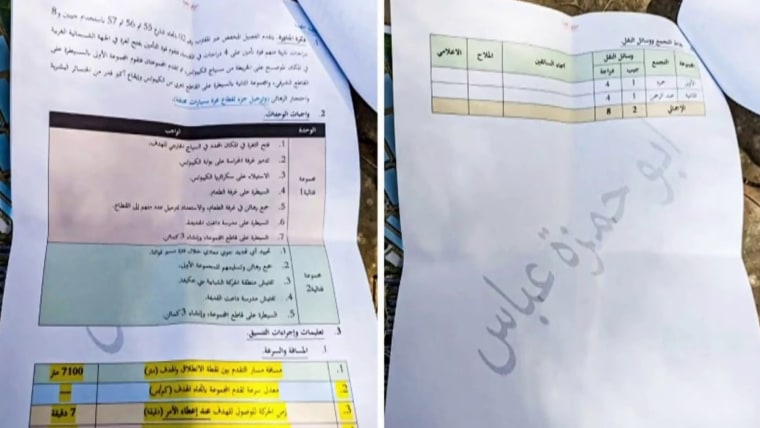
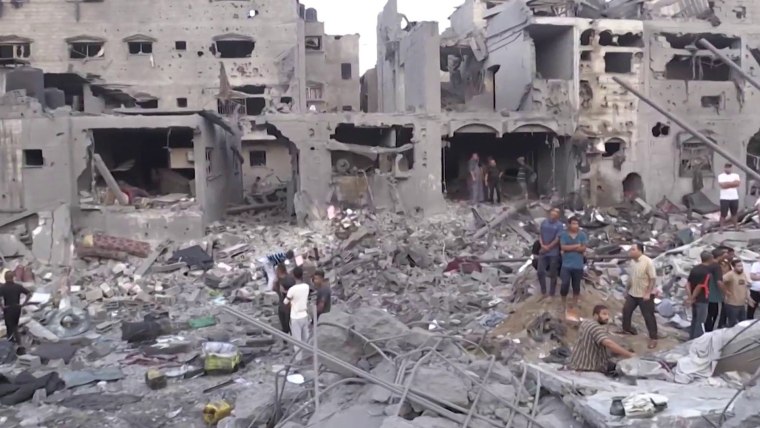

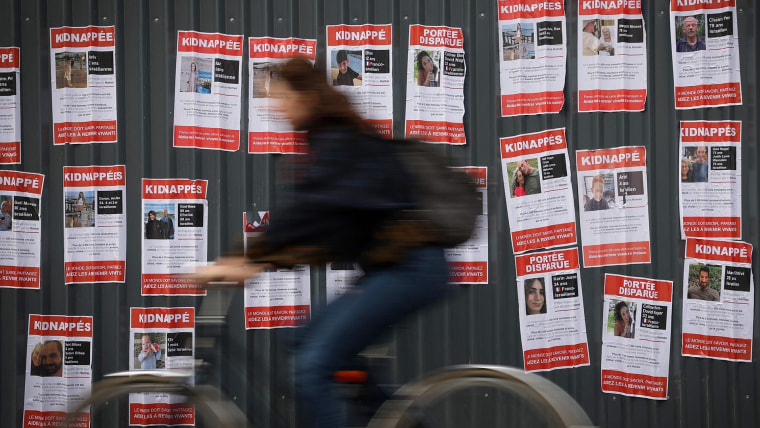
No comments:
Post a Comment